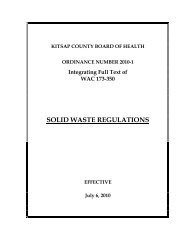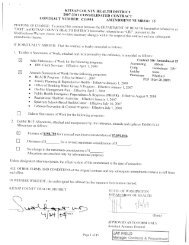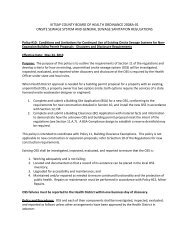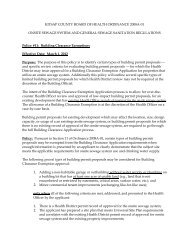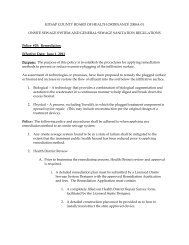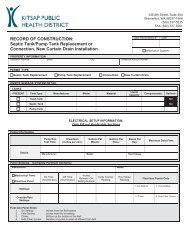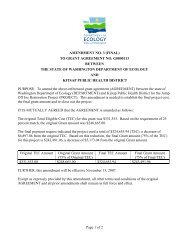(PIC) Protocol Manual - Kitsap Public Health District
(PIC) Protocol Manual - Kitsap Public Health District
(PIC) Protocol Manual - Kitsap Public Health District
Create successful ePaper yourself
Turn your PDF publications into a flip-book with our unique Google optimized e-Paper software.
<strong>Kitsap</strong> <strong>Public</strong> <strong>Health</strong> <strong>District</strong><br />
Pollution Source Identification and Correction: <strong>Protocol</strong> <strong>Manual</strong><br />
Meeting the owner/occupant<br />
If the owner or occupant (must be over 18) is there, provide a brief introduction about your visit,<br />
whether it be the reasons for the <strong>PIC</strong> project, the problem alleged in a public complaint, or deficiencies<br />
noted in the certified pumpers or maintenance specialists report.<br />
The <strong>PIC</strong> inspection form includes a checklist of topics that the inspector should address when<br />
performing the property inspection for a <strong>PIC</strong> project. Using this form, provide the owner or occupant<br />
with a copy of their OSS records (when available). This is used to provide an overview of their system.<br />
Ask whether they have been experiencing problems with odors, soggy spots, or water backing up into<br />
the house. Make site-specific suggestions to protect their OSS investment (i.e. conserve water, route<br />
surface or ground water away from OSS components, reduce waste strength, do not use harmful<br />
chemicals, and prevent physical damage to the system like driving on storing heavy equipment on the<br />
drainfield).<br />
It is important that the inspector walk over the drainfield during <strong>PIC</strong> project inspections since this will<br />
enable the inspector to assess its condition. Use this as an opportunity to educate the owner/occupant<br />
about the signs of septic system problems/failure, as well as what a properly functioning drainfield<br />
should look like.<br />
The purpose for the <strong>PIC</strong> property inspection is to provide education to the owner/occupant<br />
about their septic system including an inspection of the OSS (walk over the drainfield to assess its<br />
condition and rate the system based on this inspection). Inspectors use their best judgment regarding<br />
access to the drainfield, in some situations if it is heavily overgrown with dense vegetation such as<br />
blackberry bushes, they may not be able to assess the drainfield and should note this on the <strong>PIC</strong><br />
inspection form.<br />
During the property inspection, <strong>PIC</strong> staff should also assess other land use practices during their<br />
conversation with the owner/occupant, e.g. pet waste disposal, if livestock are present, how is manure<br />
managed, the use of fertilizers, composting and any other practices that could impact surface waters.<br />
This is a good time to identify whether the property is upland, streamside, on a marine shoreline, drains<br />
to stormwater systems, or has potential FC sources. The information from the property inspection<br />
should be recorded on the <strong>PIC</strong> inspection form. Following the inspection, <strong>PIC</strong> staff will assign a rating to<br />
the OSS. Table 2 provides the criteria for rating the onsite septic system.<br />
Revised 04/23/2013 36



